This is the second of a three-part series exploring how Ring transformed from start-up pitch to the technology powering Amazon's privatized surveillance network throughout the United States.
Ring likes to throw bangers for police.
Here’s what you’ll find at a Ring party: Open bar. Free food. Live music. A "special recognition ceremony." Free Ring doorbells. A live viewing of Shark Tank, the show that launched what would become Ring and to which company founder Jamie Siminoff eventually returned as a shark. And, most importantly, an appearance from retired basketball player Shaquille O’Neal.
You could find all this at a private party that Ring hosted for police at the 2018 International Association of Chiefs of Police conference in Orlando. Ring threw a similar party on IACP weekend this year, this time in Chicago, including appearances by both Shaq and Siminoff, according to an event invitation obtained by Motherboard using a freedom of information request. The invitation notes that firearms are strictly prohibited.
Ring—a company that has hosted at least one company party where employees wore "FUCK CRIME" shirts and racist costumes of Native and indigenous Americans, according to new images reviewed by Motherboard—wants to brand itself a friend of police, the antidote to fear of crime, and a proponent of law and order.
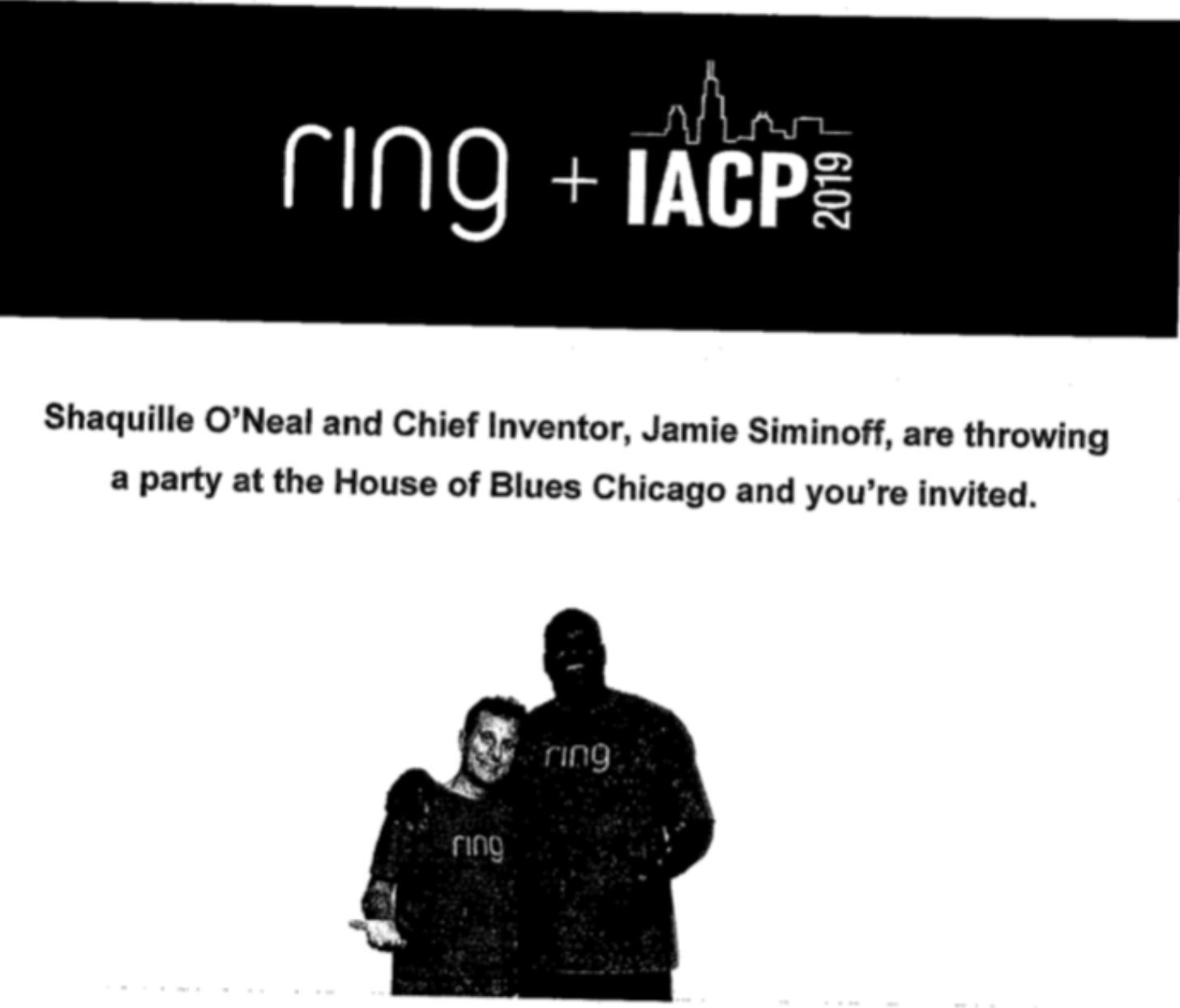
Events like these seem to have a positive effect. Emails after the 2018 Ring party show, for example, that senior police leadership were enticed by the idea of free stuff.
"The Deputy and the Chief signed up to go to the party with Shaq," a Haverhill, MA police officer told a Ring representative in an email. "But I guess the lines were really long and so the Deputy got an email for a free Ring Doorbell, only the Chief did not get his, was wondering if you know of why only one did and not the other?"
"Regarding the free doorbell, to get the email you had to have RSVPd for the event," the Ring representative said. "What does the chief want. I’ll send it."

Ring’s efforts to woo police aren’t limited to lavish parties. The company offers police officers $50 off Ring products if their department partners with Ring; those from departments that don’t partner with Ring can get discounts, too.
If Ring can sell an inviting brand image, police are more likely to trust the company. That trust is a crucial foundation for its partnerships with police, which have quietly proliferated since 2016, usually without public input.
Ring has over 600 partnerships with law enforcement agencies around the country, and this number is increasing daily. The company has spent the past three years systematically making sure police everywhere know and recognize Ring, quietly building a nationwide surveillance network through police partnerships, and embedding itself into the functions of law enforcement. This network of police partnerships isn’t only unusual because of its size and scope. Behind the scenes, Ring is experimenting with emerging technologies, as well as pursuing a partnership with at least one other private surveillance company.
The number of Ring partnerships with police grows almost daily, and, to date, there has been limited public debate about whether these partnerships should exist in the first place. Unless lawmakers curb or regulate the expansion of these partnerships, what we are seeing now is just a minuscule version of this company’s full potential.
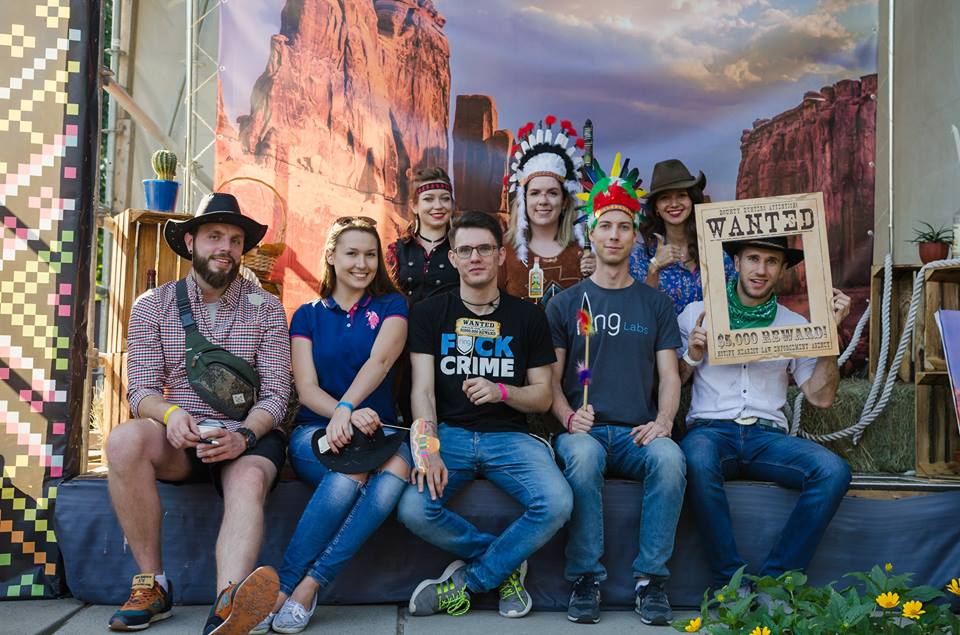
The Surveillance State Gets an Update
Motherboard has examined tens of thousands of pages of documents obtained via public-records requests from more than 90 cities that have partnered with Ring. They describe the typical relationship as a simple transaction: police get a portal where they can request footage from Ring’s network of private surveillance cameras, and the company gets the promotional muscle of the police.
In order to entice police departments into partnering with the company, Ring often tells the police the number of Ring camera owners and Neighbors app users in their jurisdiction. Sometimes, the company provides "active camera" maps showing where camera owners live.
Ring also offers police access to the Law Enforcement Neighborhood Portal, an interactive map that allows police to request camera footage directly from camera owners. (Until July, their approximate location was shown.) These owners can choose to share some, all, or none of their footage with police; police do not need a warrant in order to request camera footage from residents. The portal also includes a case management tool, in which videos associated with an investigation are sorted into groups based on case number.
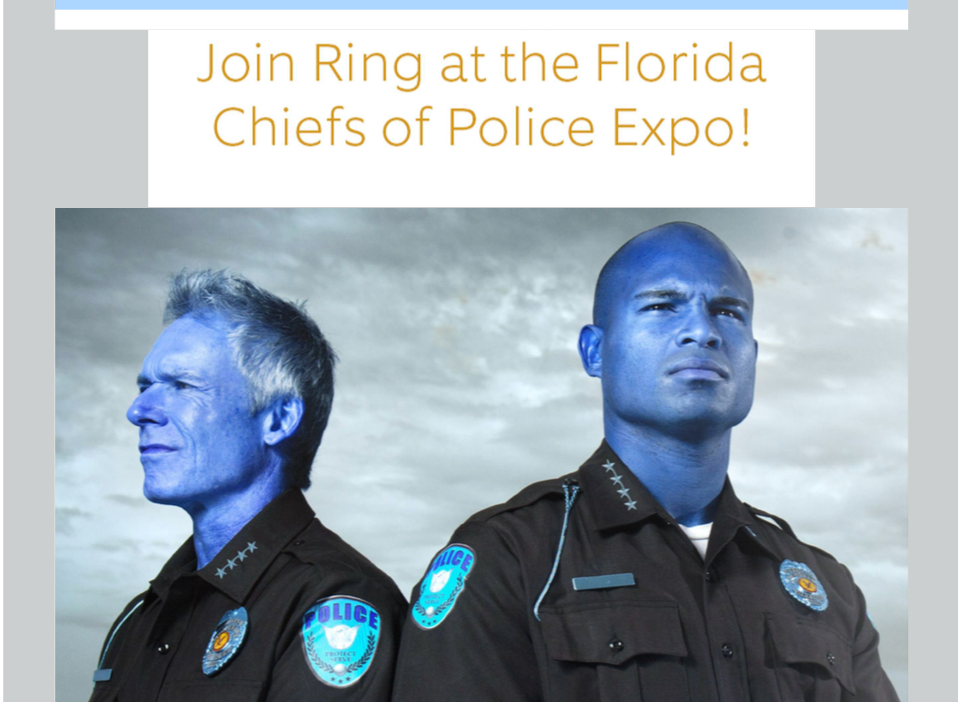
If someone refuses to provide footage to police, all police need to do is reach out to Ring. According to a memo obtained from the police department of Pomona, CA, when camera owners are "uncooperative or unavailable," officers are instructed to contact Ring and request that the captured video be preserved.
In exchange for all of this, police have to promote Ring. Some partnerships, like those in Lakeland, FL and Anne Arundel County, MD, explicitly require police to "encourage adoption" of Ring cameras and Ring’s free app, Neighbors. (Ring has told police that the more people download Neighbors, the more the Law Enforcement Neighborhoods Portal "grows in value.")
These cities receive up to 40 "seed cameras," free Ring devices they can raffle off or give away to city residents. When police share a download link to Neighbors, they can receive even more free cameras. (Ring representatives have encouraged police to post on social media often in order to "drive downloads to your unique link," and receive free Ring cameras as a "reward.")
Other cities promote Ring implicitly. All of the Ring partnership documents we reviewed require cities to have all public statements about or involving the company approved and edited by Ring PR first. Gizmodo reported that these edits sometimes remove the word "surveillance" in order to describe the function of the cameras, even though at least half a dozen cities have explicitly described Ring cameras as surveillance tools. Even Ring representatives sometimes describe their products as "motion surveillance cameras."
Additionally, according to a list of guidelines which were shared with several police departments, "any and all contact from journalists should be immediately shared with Ring."
All approved partnership announcements about police departments joining the Neighbors app include a download code that encourages residents to download Neighbors. Police officers in cities such as Green Bay, WI and Bloomfield, NJ have been updated frequently on the number of Neighbors downloads in their town which used the discount code provided in the announcement. Ring representatives often congratulate officers on achieving this.
"App downloads at 273!" a Ring representative told Green Bay police in September 2018. "Literally in 2nd place out of any department. Crushing it!"
"Cool!" a Green Bay officer replied. "How many do we need to be number 1?"
Crucially, whenever police partner with Ring, they have to sign a memorandum of understanding that requires them to keep the terms of their agreement a secret.
Ring has coached police departments that have partnered with the company on how to obtain surveillance footage from residents without a warrant. The company also provides detailed scripts to police that dictate how departments are allowed to talk about the company on Neighbors, on other social media platforms, and in real life.
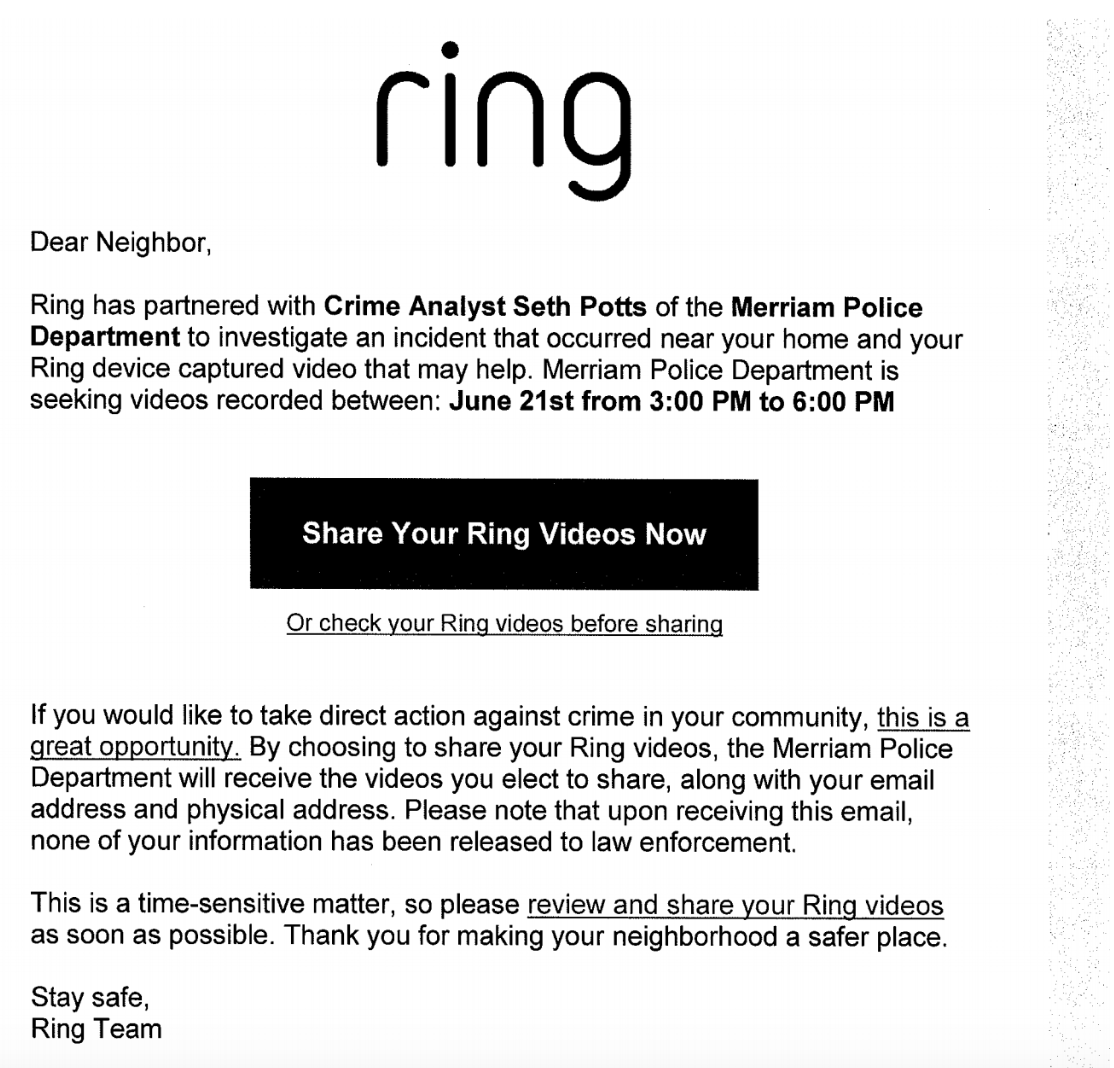
These relationships can only be expected to grow in scope. According to documents obtained by Motherboard, Ring is pursuing a partnership with Axon, a company known not just for making TASER shock devices, but for providing body cameras to police officers.
Ring’s dealings with law enforcement are not limited to the local level. Documents Motherboard obtained from the Tennessee Bureau of Investigation, a state-level policing and investigative agency, show that Ring has pursued a relationship with the agency. The agency reached out to Ring after footage from a Ring camera helped lead to the arrest of a wanted criminal. Ring, in turn, spoke to TBI representatives about how its partnerships work and provided a memorandum of understanding for the agency to sign. TBI representatives said that they have not signed any documents at the time of writing.
A federal public records request sent to the FBI came back with a GLOMAR response, meaning the FBI could neither confirm nor deny the existence of correspondence with Ring.
The Law Enforcement Neighborhood Portal
The Law Enforcement Neighborhood Portal is the coveted tool at the core of all police partnerships with Ring. It’s free, so long as police agree to and meet all of the terms outlined in the memorandum of understanding with the company. It launched in April 2018, the same month that Amazon finalized its acquisition of Ring, according to a letter provided to Senator Markey in November 2019.
Motherboard obtained a video that shows how the Law Enforcement Neighborhoods Portal worked in 2018. This video shows the approximate location of Ring camera owners, but in July, Ring removed any indication of customer location, following months of reporting about the privacy implications of showing police such data.
Sometimes, as reported by Gizmodo, Ring taps into police departments’ computer-aided dispatch feeds, which include data provided by 911 callers and information about the person who made the call, like name and address. Ring uses this information to make "News Alerts" about crime in the Neighbors app.
As reported by CNET, Ring is working on building a tool that will allow police to activate Ring cameras and automatically start recording.
Doubts from Police
Police have sometimes expressed concerns about the implications of partnering with a private surveillance company.
"Question I have is this… if I share a video of someone at my home engaged in perfectly legal conduct does it reflect only on me or does the department share liability for sharing it as well," a police commander from Waynesboro, VA asked his colleagues in March, in emails obtained by Motherboard. "I can see some people being offended at being dubbed ‘strange’ for simply knocking on a door in daylight and leaving a brochure or whatever. Think Jehova’s witnesses…."
"We can’t control what other people share or post," the chief of police replied. "Ring monitors and controls all posted content not us."
"Huge investigative resource to have access to 700 surveillance cameras," a police officer from Chatham, NJ asked his colleagues in May, according to emails obtained by Motherboard. "May cause pushback from some members of the public, similar to San Francisco outlawing facial recognition technology? I admit I’m surprised. (I’ve seen the Ring ad on TV many times, but they never mentioned their videos are captured and stored. They may be sensitive to this as a potential privacy issue.)"
In August, members of the Edgewood, WA police department circulated a Washington Post story about the proliferation of Ring’s partnerships with police, according to emails obtained by Motherboard.
"You will likely be getting inundated with Private Rights Advocates and stuff, as the Ring stuff is very controversial," one person replied.
Another officer replied and said that he did not understand the concerns.
"The only thing that we can do that is different from what we are already doing," he said, is the ability to "draw a ‘geo-fence’ on a map" and "send a message to all Ring owners" within the area about footage that may be of interest. In other words, he said, Ring just speeds up the process of going door-to-door and asking people with security cameras for their footage.
Ukraine’s American Data Moderation
It’s unclear whether police are aware that people doing crucial and sensitive work related to the Neighbors app, which feeds into the Law Enforcement Neighbors Portal, are sometimes based outside the United States.
Some "data moderators," for instance, who "pre-moderate" videos, images, and text on Neighbors and deliver "instant crime and safety alerts" based on dispatch data obtained by Ring from police, work out of Ring’s offices in Kiev, Ukraine.

A Ring spokesperson declined to say how much of Neighbors’s moderation is outsourced to Ukraine, or which regions of Neighbors activity are outsourced to Ukraine. ("The Neighbors app has community guidelines, moderators, extensive trainings for those moderators, user flagging capabilities, and other tools in place to support our communities," a Ring spokesperson said in an email.)
Data moderators in Ring Ukraine are required to have upper-intermediate to advanced English-speaking skills, but there is no standard of knowledge for U.S. history, current affairs, or the social realities resulting from a legacy of slavery and colonialism.
This is concerning not just because the Neighbors app has a major problem with racial profiling, but because Ring Ukraine in particular has a history of flagrant racism and ignorance of American racial politics.
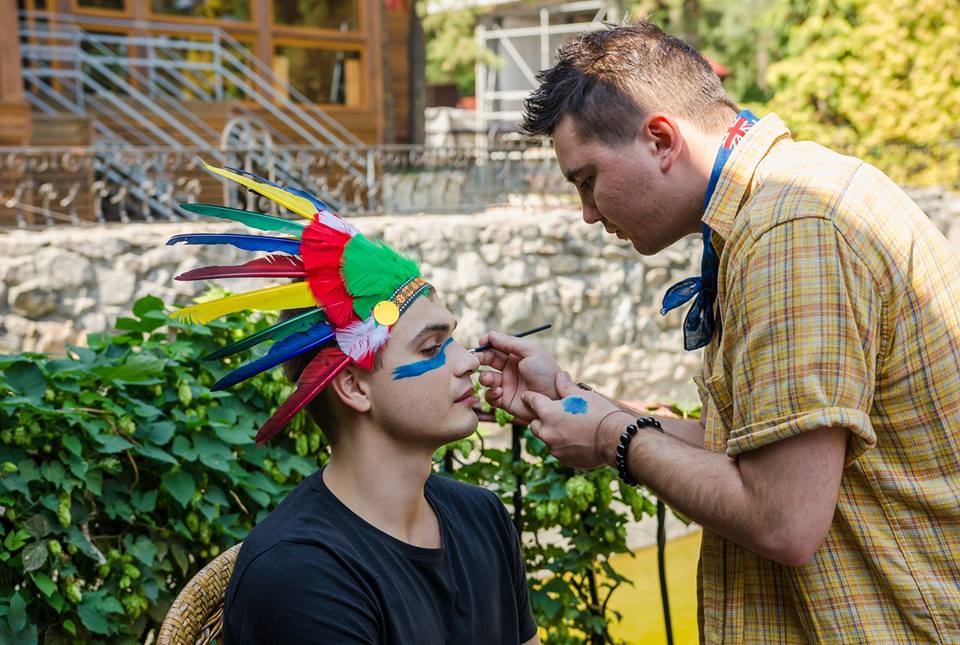
In an album the team uploaded to Facebook in September 2017, dozens of white employees are shown wearing racist costumes of Native and Indigenous Americans. (The album was removed after Motherboard brought it to Ring’s attention.) The costumes included face paint and tribal headdresses that distort the religious traditions and cultures of indigenous persons.
"That event is not representative of who we are as a company," Ring said in an email to Motherboard. "At Ring, we strive to be an inclusive community and we’re taking action to ensure that all of Ring events reflect our values."
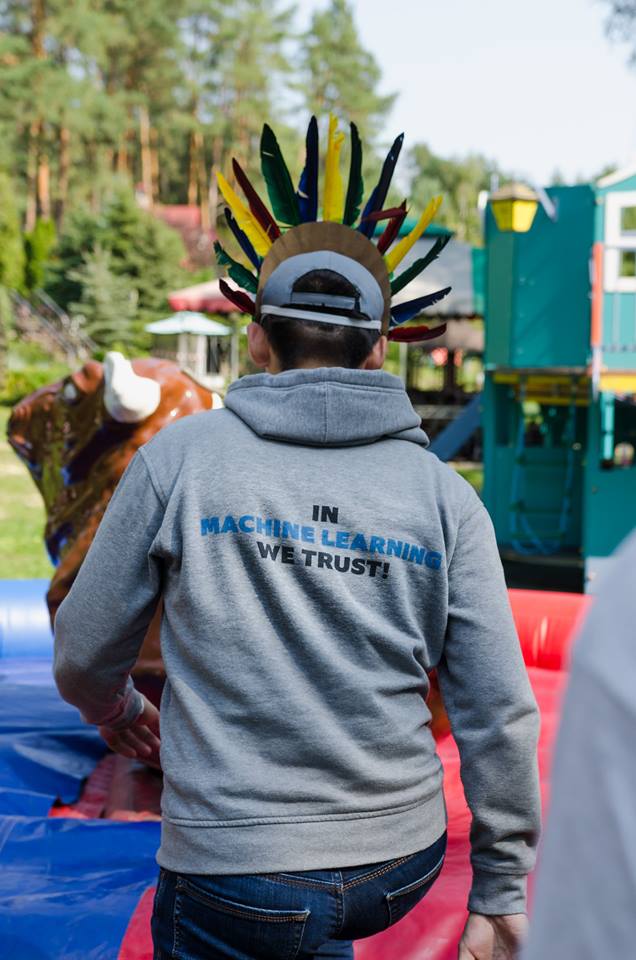
The album, titled "Wild West Party in Ring Labs," shows that the team appeared at the time to be exclusively white. In the same album, several employees are wearing shirts and sweatshirts that say "FUCK CRIME" and "IN MACHINE LEARNING WE TRUST."
Why Ring Went to Ukraine
When Ring opened its Ukraine office In 2016, it was still facing issues with the quality of its cameras. The company was looking to introduce new features, so it opened a research and development office in Kiev. This quickly became a central hub for developing new products and services.
If successful, features like object or facial recognition could make Ring more user friendly. A user probably doesn’t care about their kids coming home from school, for instance, but they probably do care about a stranger coming to the door. That’s why Siminoff has pushed this research heavily, according to The Information. Kira Rudik, Ring Ukraine’s chief operating officer, said in 2018 that Ring’s Kiev office is Ring’s largest technical center.
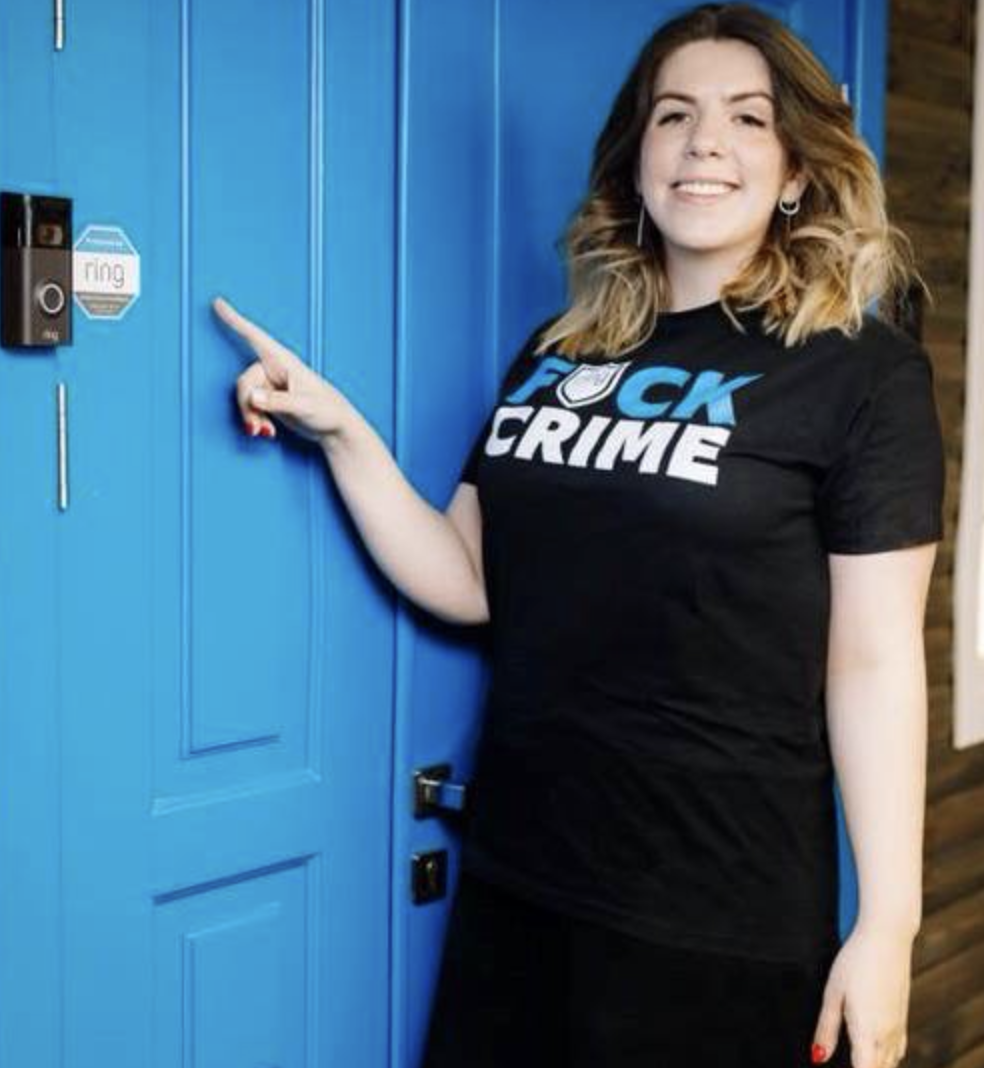
Ring’s Terms of Service state that "by purchasing or using" Ring products and services, you give Ring the right "to access and use your User Recordings" for "developing new Products and Services." However, the company isn’t upfront about what these services are, or the fact that many of them are developed overseas.
Documents obtained by Motherboard—including internal documents, public job listings, and outspoken newspaper coverage in Ukraine—show that for years, Ring has been developing audio and voice analysis, facial recognition and identification, and object detection and recognition in Ukraine. (When asked in connection with reporting for a previous article, Ring said that it does not have facial recognition.)
A version of Ring's Ukraine website which was current as of October 2018 said that the team was developing "semi-automated crime prevention and monitoring systems which are based on, but not limited to, face recognition, person re-id, objects classification."
We also obtained presentation slide from a source that describes the role of Ring’s "Head of Cloud Research" in 2018. His responsibilities included oversight of "audio analysis, " "facial recognition and re-ID," and "object detection and recognition." The same Head of Cloud Research has also posted papers on GitHub that describe methods for these features.
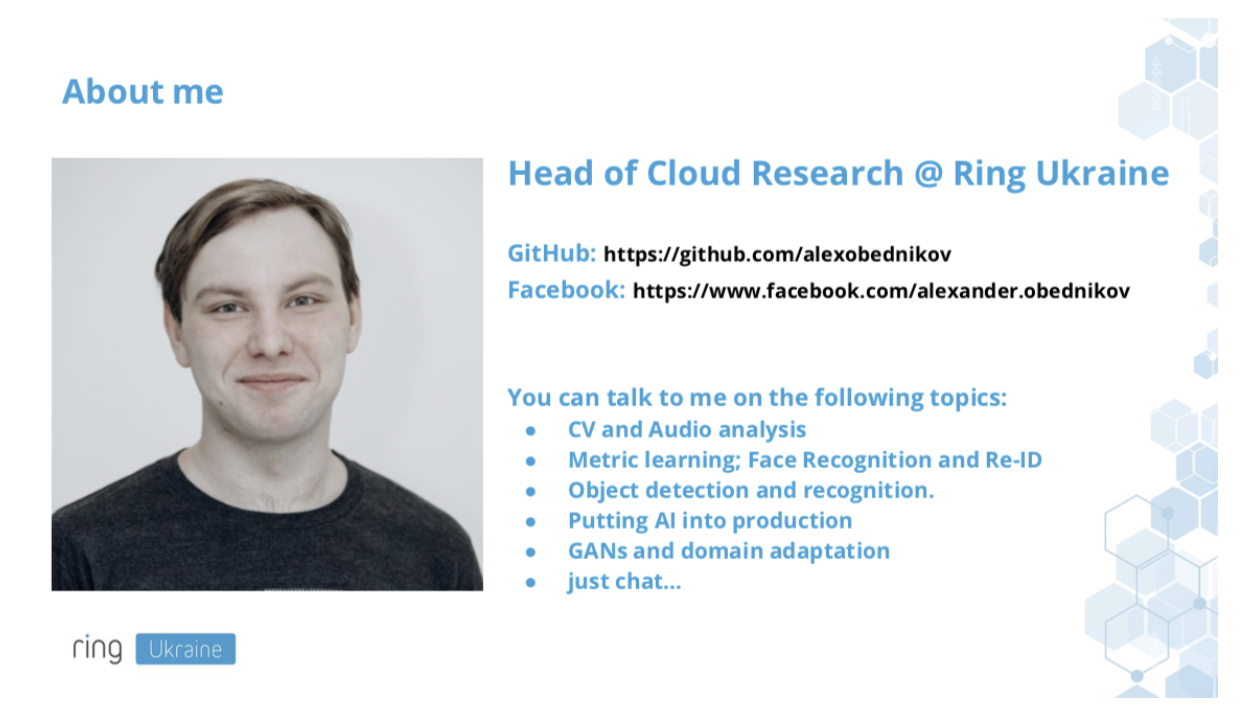
Object recognition is already being introduced to some Ring users. According to recent posts in a Facebook group for Ring users, people with Android devices were recently given the option of "People Only Mode." According to the in-app description, it allows users to "only be notified about people" captured on their camera. By necessity, this feature could only function through object recognition that can differentiate a person from, say, a dog or an animal.
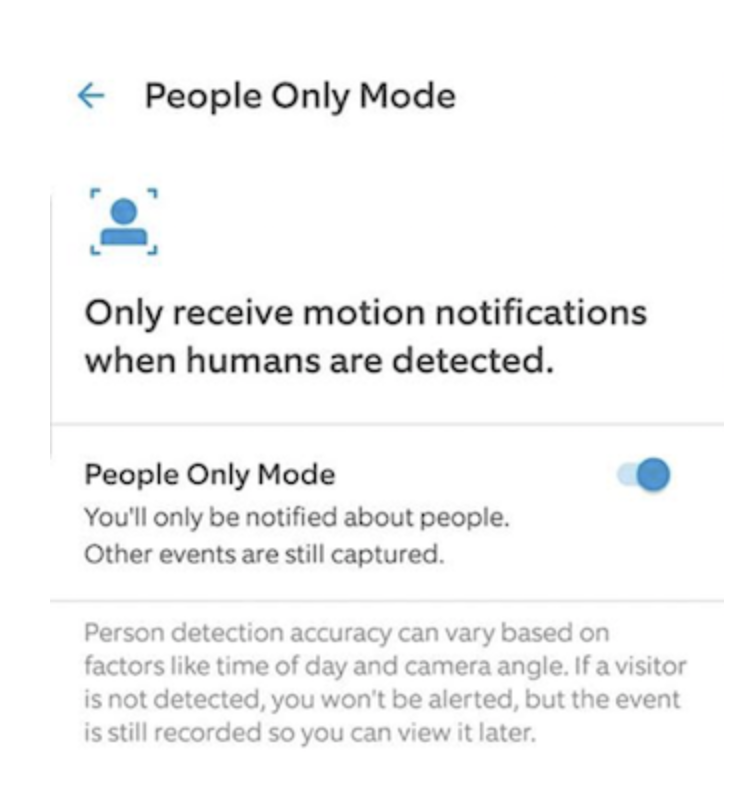
Ring’s Ukraine office has a history of loosely handling customers’ personal, identifiable data. As reported by The Information, when the office first launched, "customer videos were widely shared there." Ring claims that today, only videos that customers on the Neighbors app are used for product research. However, Ring hasn’t said when this change occurred.
Alfred Fox Cahn, a founder of the anti-surveillance advocacy group STOP NY Spying and counsel for Immigrant Leaders Council of the New York Immigration Coalition, said that this change is still problematic. People being used to develop facial, voice, and object recognition almost never consent.
"Whether it's the mailman, whether it is someone doing, you know, dropping off packages, whether it's the neighbor across the street, who’s potentially captured by increasingly high resolution cameras—there's an entire neighborhood of individuals whose privacy is being sacrificed by one homeowner," Cahn said. "That becomes increasingly problematic when those people's data is then being harvested as part of the biometric collection effort, and being analyzed by Ring's team."
In May 2018, one month after Ring was acquired by Amazon, representatives from Amazon reportedly visited the Ukraine office and restricted employee access to unspecified types of sensitive customer information. Individual employees had to apply to get data access. However, they reportedly "found a workaround" allowing workers to access customer information "from any computer, at home or anywhere."
A spokesperson for Ring said in an email that it has a "zero tolerance" policy for privacy abuse and has "strong privacy protections" for who can access Ring video.
"We hold our team members to a high ethical standard and anyone in violation of our policies faces discipline, including termination and potential legal and criminal penalties," the spokesperson said. "All personal information is treated with high confidentiality. We use multi-factor authentication to restrict access, service encryption, and audits of our control environment to protect it and users can delete their stored videos at any time."
Ring continues to store sensitive customer information in order to develop new machine learning-based products in Ukraine, according to The Information.
According to a new report from the Intercept, Ring has planned neighborhood "watch lists" powered by facial recognition These watch lists would allow Ring camera owners to be alerted when a "suspicious" person on a company watch list entered their camera's frame.
An Endless Database of Footage
Evan Greer, deputy director of privacy advocacy group Fight for the Future, said that using technology to make policing faster, cheaper, and more efficient can fundamentally change how law enforcement plays out.
"[Automation] removes this natural limitation that's actually really important, because it incentivizes law enforcement to use their resources appropriately and, and in a measured way," Greer said. "But if you can basically let a computer do that work, it enables the enforcement of laws and the enforcement of social behavior, or social control at a mass scale that would otherwise be impossible."
Alternatively, there’s the argument that footage from surveillance cameras provides an "objective" eye on the scene that protects do-gooders and enables justice. But video footage does not always amount to accountability within the criminal justice system. The deaths of Freddie Gray and Eric Garner at the hands of police were both caught on camera, but none of the police officers faced criminal prosecution for their actions.
Alfred Fox Cahn, the anti-surveillance advocate, believes that because photos and videos can be recorded and shared easily, people have the sense that more data is the solution to injustice.
"We see the ability of photos and videos to rapidly be shared, and there's this belief that somehow our new narrative is less compelling unless we have the footage to back it up," Cahn said. "I think that drives a lot of people to get the systems, partially out of fear that if something were to go wrong, that they would not be able to advocate for themselves as well without the system."
Greer also said that although Ring isn’t currently deploying facial recognition, police can easily apply in-house facial recognition to footage obtained by Ring cameras. In fact, she said, having a lot of surveillance footage can encourage police to use facial recognition.
"If police have access to this, just like astronomical trove of footage, they're not even going to know what to do with it," Greer said. "And so then they're incentivized to use computers, or use algorithms, to sift through it for stuff that they might want to use. That increases the chances to which this is being used for dragnet surveillance, for essentially monitoring the entire population in ways that aren't actually that helpful for keeping people safe, but are super helpful for keeping people in line."
It’s unclear what Ring’s partnership with Axon currently looks like, or could look like. However, it shows that Ring is planning on expanding its involvement with the process of law enforcement. It seemingly has no plans to slow or reduce it.
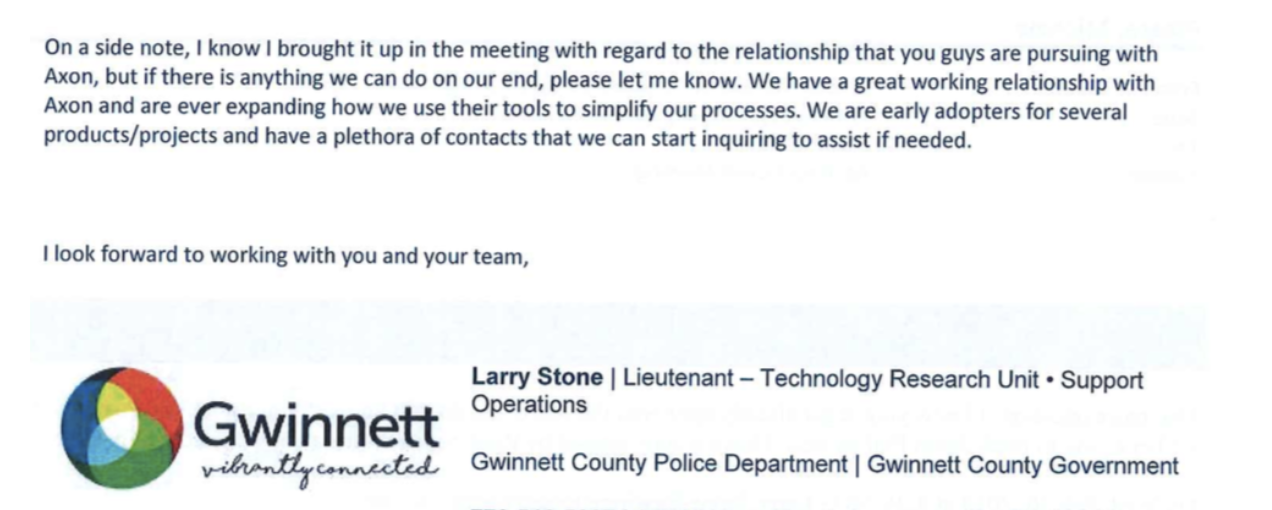
"There is a battle going on to become the platform for policing, and I think Amazon is beginning the process of engaging in a battle," Ferguson said. "They're offering a whole suite of services to be the platform for policing."
"It is Axon’s policy not to comment on or disclose details from conversations with potential partners," an Axon representative said in an email to Motherboard.
If Police Want Footage, They Can Get It
Ring makes a very simple pitch to police: People are already buying these security cameras, so why not partner with us and take advantage of that?
But Ring takes the idea of voluntary camera registries and warps it. If you buy a Ring camera, and if your police department partners with the company, your camera is automatically inducted into a platform that allows police to request footage from you. There is no choice involved.
Of course, users need to give police permission to get their videos. But there is a power imbalance built into all interactions between civilians and law enforcement. Ferguson said that this imbalance favors the interest of law enforcement, and the imbalance is even more severe when civilians represent marginalized communities.
"The courts usually ignore the larger societal impacts of authority and requests from authority, and how it's really hard to say no," Ferguson told Motherboard. "I technically have the right to say no, but it’s very hard to say that. And it will be even harder if I were younger, or if I wasn't a lawyer, or if I was a person of color, or I live alone, or it was two in the morning. And some of those sort of contextual realities get ignored."
Even if users say no, there are other ways for law enforcement to obtain the footage. Greg Nojeim, a senior counsel at the Center for Democracy and Technology, said that if police can indicate probable cause that criminal activity was captured on Ring cameras, they can get a court warrant and obtain that footage without user consent.
In September, Cahn moderated a discussion between the West Orange Chief of Police and activists from the local and national civil rights groups Essex Rising and Color of Change. Cahn said that while he was happy the police chief spoke to activists, he was concerned by what the police did not know about Ring.
"It was somewhat disturbing to hear that they hadn't done research into privacy and digital bias issues until after the MOU had already been signed," Cahn said. "He had not been familiar with any of the concerns around research and development for facial recognition. He hadn't known about any of the well-documented issues around privacy."
"They, according to the chief, were relying on the assertions made by Ring that they took privacy seriously," Cahn added. "And hadn't done any external due diligence beyond that."
Law Enforcement’s Best Friend
In November 2018, police officers from Paradise Valley, AZ received an email from Ring. It thanked police for coming to their party on IACP weekend, and provided a link to get a free RIng camera.
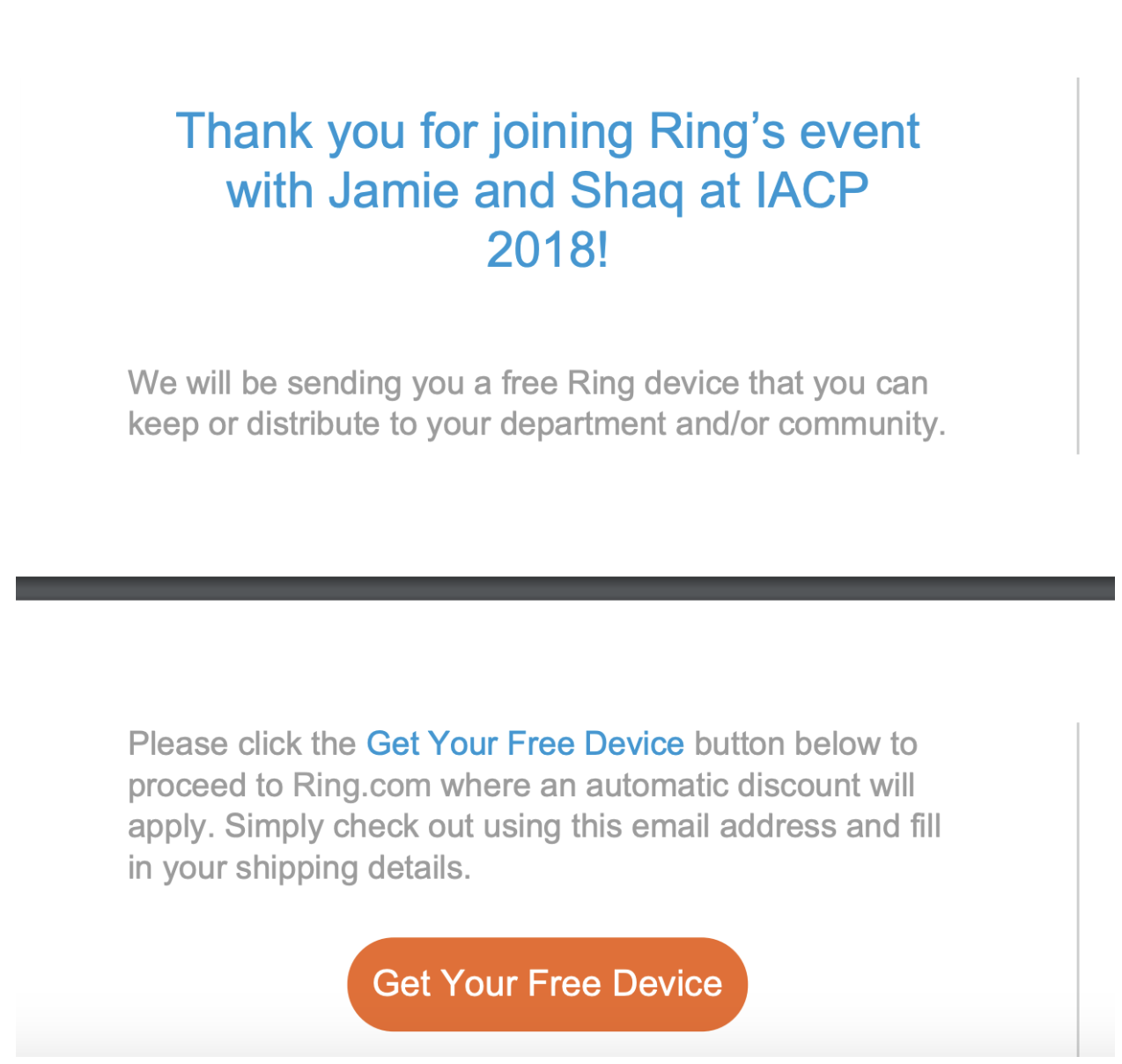
"Now we’re inviting law enforcement to access this platform and utilize a new crime-fighting tool," the email continued. "It’s called the Neighbors Portal, and it’s completely free for law enforcement. Reply to this email to schedule a time to discuss how the Neighbors Portal can help your department and community."
In February 2019, according to documents obtained by Motherboard, the Paradise Valley Police Department partnered with Ring.
There are a lot of companies that sell products that are comparable to Ring’s cameras. Google Nest, Bink, Vivant, and ADT, for instance, all sell doorbell cameras. However, none of these companies have gone out of their way to woo and befriend police the way Ring has.
In Chandler, AZ, police were in talks with Ring about a partnership. Wanting to do due diligence, an officer emailed home surveillance companies Blink, Nest, and Canary in December 2018 asking if they "offer a grant or discount code" for communities.
"The chandler police department is wishing to push security cameras to our community," he explained.
Blink offered a temporary 15 percent city discount. None of the other companies responded. Ring, meanwhile, offered 25 free cameras. Chandler ultimately partnered with Ring, and agreed to promote the company to the community.
Ring knows that it can entice people by offering free things. And police rarely say no.
from VICE https://ift.tt/363Yh3e
via cheap web hosting
No comments:
Post a Comment